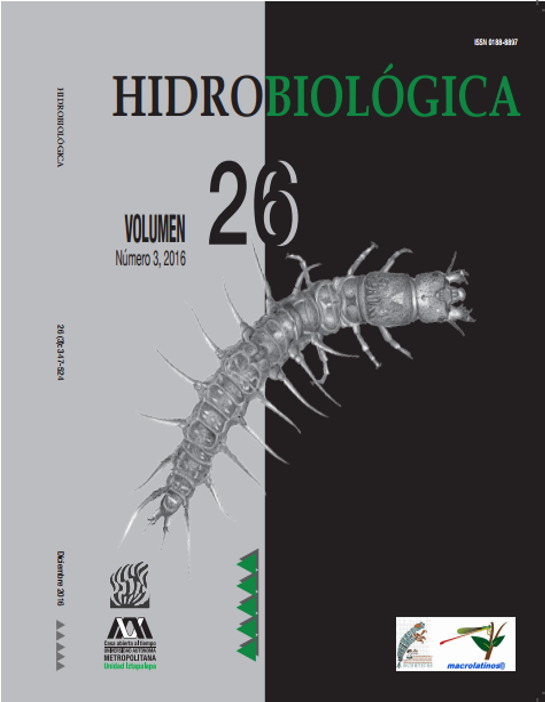La comunidad de macroinvertebrados bentónicos litorales como un reflejo de la heterogeneidad ambiental
DOI:
https://doi.org/10.24275/uam/izt/dcbs/hidro/2016v26n3/AlcocerPalabras clave:
Lago maar, macrobentos, México, lago salino, lago tropicalResumen
La zona litoral de un lago provee hábitats con heterogeneidad espacial caracterizada por las variables físicas y químicas del agua y sedimento que en el presente estudio han permitido describir la estructura y variabilidad de la distribución espacial de la comunidad de macroinvertebrados bentónicos (MIB) del lago Alchichica, Puebla. El descenso del nivel del lago y la presencia de un anillo discontinuo de estromatolitos ha generado una zona litoral heterogénea con regiones totalmente comunicadas con la zona limnética hasta zonas totalmente aisladas del resto del lago. De esta forma, se presenta un gradiente en el proceso de desecación del lago. Objetivos. Lo anterior, permite describir el efecto de la desecación sobre la estructura comunitaria de los MIB. Métodos. Se establecieron 11 estaciones a lo largo de la zona litoral del lago. En cada estación se midieron variables ambientales y se muestrearon los macroinvertebrados bentónicos. Resultados. Se reconocieron 21 taxones de MIB entre los cuales predominaron por su abundancia y frecuencia el oligoqueto Limnodrilus hoffmeisteri y el anfípodo Hyalella azteca. Ambientalmente se distingue una separación entre las estaciones que muestran un mayor grado de comunicación con el cuerpo principal del lago de las que están casi o totalmente aisladas del mismo. Conclusiones. Conforme se incrementa el grado de aislamiento decrece la riqueza taxonómica, la diversidad, la diversidad máxima y la equidad pero no así la abundancia. La textura sedimentaria también cambia de un sustrato arenoso en las estaciones comunicadas, a uno limo-arcilloso en las aisladas, lo cual favorece un cambio del taxón dominante que va de H. azteca en las arenas a L. hoffmeisteri en el limo-arcilloso.Descargas
Descargas
Cómo citar
Número
Sección
Licencia
Los autores/as que publiquen en esta revista aceptan las siguientes condiciones:
De acuerdo con la legislación de derechos de autor, HIDROBIOLÓGICA reconoce y respeta el derecho moral de los autores, así como la titularidad del derecho patrimonial, el cual será cedido a la revista para su difusión en acceso abierto.
Publicar en la revista HIDROBIOLÓGICA tiene un costo de recuperación de $500 pesos mexicanos por página en blanco y negro (aproximadamente 29 dólares americanos) y $1000 pesos por página a color (aproximadamente 58 dólares americanos).
Todos los textos publicados por HIDROBIOLÓGICA sin excepción se distribuyen amparados bajo la licencia Creative Commons 4.0Atribución-No Comercial (CC BY-NC 4.0 Internacional), que permite a terceros utilizar lo publicado siempre que mencionen la autoría del trabajo y a la primera publicación en esta revista.
Los autores/as pueden realizar otros acuerdos contractuales independientes y adicionales para la distribución no exclusiva de la versión del artículo publicado en HIDROBIOLÓGICA (por ejemplo incluirlo en un repositorio institucional o publicarlo en un libro) siempre que indiquen claramente que el trabajo se publicó por primera vez en HIDROBIOLÓGICA.
Para todo lo anterior, el o los autor(es) deben remitir el formato de Carta-Cesión de la Propiedad de los Derechos de la primera publicación debidamente requisitado y firmado por el autor(es). Este formato se puede enviar por correo electrónico en archivo pdf al correo: enlacerebvistahidrobiológica@gmail.com; rehb@xanum.uam.mx (Carta-Cesión de Propiedad de Derechos de Autor).
Esta obra está bajo una licencia de Creative Commons Reconocimiento-No Comercial 4.0 Internacional.


